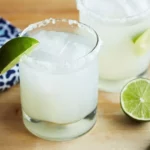Liquor in a Margarita is the alcoholic ingredient that gives the cocktail its kick. It’s usually tequila, a Mexican spirit made from agave plants, but sometimes other spirits like rum are used in creative variations. The liquor blends with lime juice and triple sec to create the Margarita’s unique flavor.
If you’ve ever wondered, “What kind of liquor is in a Margarita?” you’re not alone. Margaritas are known for their tantalizing mix of flavors, and it all starts with tequila. Tequila, a spirited Mexican beverage, forms the heart of this beloved cocktail. But that’s just the beginning of the story of this delightful drink.
Best liquor for margaritas
Espolòn Blanco:The pure and clean taste of this tequila, with hints of sweet agave, pepper, and vanilla, is well-known. Espolòn Blanco, unaged, offers a crisp and fresh flavor, making it an excellent choice for a classic Margarita.
Patrón Silver: A popular premium tequila, Patrón Silver is smooth and well-balanced, with a light, fruity, and slightly citrusy flavor. It’s a top choice for those looking to make a more refined and smooth-tasting Margarita.
Don Julio Blanco: This is a premium tequila that offers a crisp agave flavor with notes of citrus. It’s smooth and clean, making it an excellent choice for Margaritas, as it complements the lime and triple sec flavors without overpowering them.
Herradura Silver: Aged for 45 days, Herradura Silver has a slightly woody taste with hints of agave, green apple, and citrus. This slight aging adds a subtle complexity to the Margarita, making it a favorite among many tequila enthusiasts.
Casa Noble Crystal: This is an organic tequila that’s triple distilled for exceptional smoothness. It has a full-bodied flavor with notes of agave, lime, and a touch of floral. Its smoothness and subtle complexity make it a fantastic choice for an elegant Margarita.
Liquor history
The history of liquor dates back thousands of years.Ancient civilizations, including the Chinese, Egyptians, and Greeks, developed early distillation techniques, tracing the origins of this practice. In the Middle Ages, European monks refined distillation methods for medicinal purposes.
As exploration expanded, so did the global trade of spirits like rum, brandy, and gin. The 18th century saw the rise of whiskey in Ireland and Scotland. Prohibition in the United States in the 1920s gave birth to bootlegging and speakeasies. Today, liquor production is a global industry, with diverse spirits and rich traditions enjoyed worldwide.
Key Ingredients and Their Impact
The following table summarizes the key ingredients of a Margarita and their impact on the cocktail’s flavor.
| Ingredient | Type | Description | Flavor Impact |
| Tequila | Primary Liquor | Distilled from blue agave; types include Blanco, Reposado, Añejo | Provides the base flavor; type determines smoothness and complexity |
| Triple Sec | Secondary Liquor | Orange-flavored liqueur; brands include Cointreau, Grand Marnier | Adds sweet citrus notes; brand choice affects sweetness and depth |
| Lime Juice | Mixer | Freshly squeezed lime juice | Adds tartness and freshness, balancing the sweetness and alcohol |
| Salt | Garnish | Coarse or fine salt on the rim | Enhances flavors, adds a savory element |
Understanding these components and how they interact is key to mastering the art of Margarita making.
Are margaritas tequila or rum?
Margaritas are traditionally made with tequila, not rum. Tequila, a distilled spirit made from the blue agave plant, is the primary and essential alcohol base in a classic Margarita. This Mexican spirit provides the distinctive flavor profile that is fundamental to the identity of the Margarita cocktail.
While there are many cocktail recipes that use rum, the classic Margarita is not one of them. There are always variations and twists on classic recipes, so you find some Margarita-inspired cocktails that use rum instead of tequila, but these would not be considered traditional Margaritas.
Is margarita the same as tequila?

Tequila: The blue agave plant is used to distill this type of spirit, primarily in Mexico. People can consume tequila as a standalone alcoholic beverage or use it as an ingredient in various cocktails. It comes in different varieties like Blanco, Reposado, and Añejo, each with its own flavor profile.
Margarita: This is a cocktail that includes tequila as one of its main ingredients. A classic Margarita typically combines tequila, triple sec (an orange-flavored liqueur), and lime juice. Salt is often placed on the rim of the glass when serving this mixture. The Margarita, a specific mixed drink recipe that utilizes tequila but also incorporates other ingredients, creates its unique taste.
What is liquor
The distillation of grains, fruit, or vegetables that have undergone alcoholic fermentation produces liquor, also known as spirits. The distillation process purifies the liquid and removes diluting components like water, for the purpose of increasing its proportion of alcohol content (commonly expressed as alcohol by volume, ABV).
High Alcohol Content: Liquor typically has a higher alcohol content than beer or wine. While beer and wine usually have alcohol contents ranging from about 3% to 15%, liquors often start at around 20% ABV and can go much higher, some even up to 40-50% ABV or more.
Variety and Types: There are numerous types of liquors, each with distinct flavors and characteristics. Common types include vodka, rum, tequila, gin, whiskey, and brandy. These spirits are diverse in their base ingredients and production processes, resulting in a wide range of flavor profiles.
Consumption Methods: Liquor can be consumed neat (without any additives), on the rocks (with ice), or as a base for cocktails. Cocktails often mix liquor with other ingredients like syrups, juices, or soda to create different flavors.
Regulation and Aging: Often, authorities heavily regulate the production of liquor, imposing specific laws that govern the methods and ingredients. Various types of liquors, like whiskey and rum, undergo aging in barrels for different durations, impacting their flavor and quality.
Is Liquor Gluten Free
Pure distilled liquors, such as rum, tequila, vodka, gin, and whiskey, are naturally gluten-free as distillation removes gluten proteins. Be cautious with flavored or malt beverages, as they may contain gluten. Checking ingredients or looking for gluten-free labels is important for those with gluten sensitivity or celiac disease. Consult a healthcare professional if you have concerns about specific liquors affecting your sensitivities.
Conclusion
The Margarita is a timeless cocktail celebrated for its simple yet delightful combination of tequila, triple sec, lime juice, and salt. The choice of tequila, whether it’s the crisp Blanco, the mellow Reposado, or the complex Añejo, plays a pivotal role in shaping the Margarita’s flavor. Triple Sec, with its sweet citrus notes, adds that perfect touch of balance.
The perfect Margarita is an art, and it’s all about quality ingredients and precise measurements. Whether you prefer it sweet, strong, or with a fruity twist, the Margarita’s versatility allows for endless variations.
The Margarita is more than just a cocktail. It is a symbol of relaxation and celebration. Its rich history and wide array of interpretations have made it a favorite in bars and homes around the world. So, the next time you savor this classic drink, remember the harmonious blend of liquor, Triple Sec, and lime that makes the Margarita a timeless and beloved choice for any occasion.
FAQs
How is liquor made?
The fermentation and distillation of grains, fruits, or vegetables make liquor.
What is the alcohol content in liquor?
Liquor typically has a higher alcohol content than beer or wine, often over 20% ABV.
Is liquor regulated?
Liquor production often undergoes heavy regulation, with laws governing methods and ingredients.
What is the difference between liquor and spirits?
People often interchangeably use “liquor” and “spirits” to refer to alcoholic beverages.





